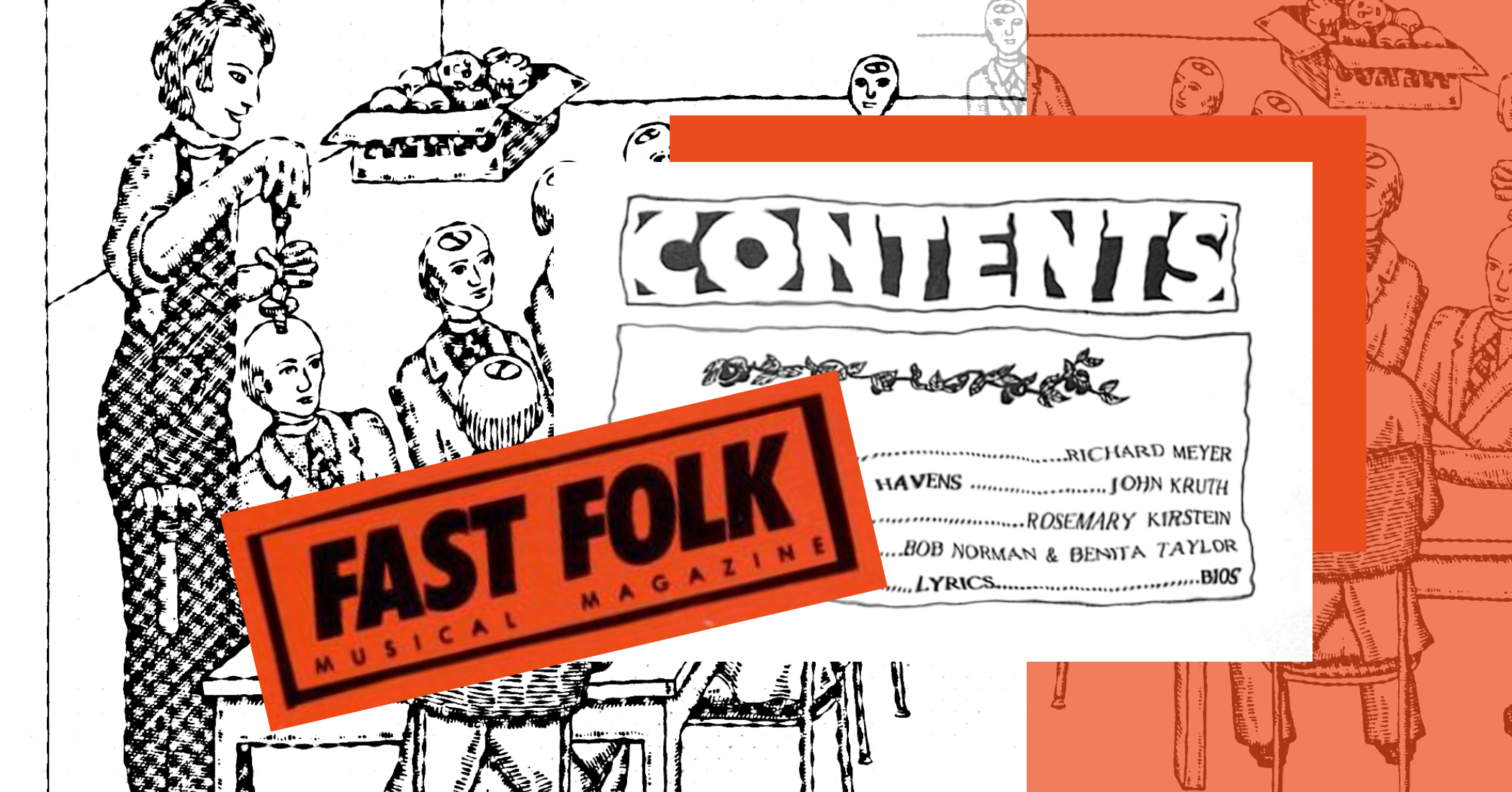Redefining Folk via Fast Folk Musical Magazine
By Erin Christie
When I bought a random edition of Fast Folk Musical Magazine’s LP compilation series this summer, I had no idea I was stumbling upon a Smithsonian-lauded piece of New York’s sonic history.
Fast Folk Musical Magazine (previously called The Co-Op) was founded in New York in 1982, in the midst of a musical landscape ripe with singer-songwriters looking for their big break. Organized under the guidance of iconic folk artist Jack Hardy, the songwriter/performer cooperative and non-profit aimed to provide local musicians with an outlet through which they could release their first recordings, unveil their demos, and, otherwise, share their work with the greater Greenwich Village and nationwide music communities.
Though an unfortunate expiration date of the venture arrived in 1997, that’s not to say that they went out without a massively impactful legacy in tow. After its first edition, Fast Folk released dozens of compilations and accompanying print issues throughout their 15-year run. Historically, they featured over 600 writers and over 2,000 songs in total, including content from artists who later spearheaded musical genres such as alternative country and anti-folk. They even hosted early recordings from later Grammy Award-winners such as Lyle Lovett, Suzanne Vega, Julie Gold, Tracy Chapman, and Shawn Colvin, among many others.
The copy I came across — Volume 3, No. 10; dated December 1986 — was tucked away among the records in the “local” section at the Allston location of the record store franchise, In Your Ear. Upon finding it, I was immediately compelled by it’s cover artwork: a hand drawn design, exhibiting two spindly, distorted figures engaging in a sort of synchronized dance, painted over with what looked like bright pink watercolor. Maybe you aren’t meant to “judge a book by it’s cover,” or “judge a record by it’s cover,” in this case, but I undoubtedly did. When I got home that evening after purchasing it, I found the compilation record, alongside a copy of the print issue that went along with it inside— needless to say, my impulse decision had led me to unknowingly uncover a motherload of early folk excellency.
Compilation-wise, Volume 3, No. 10 features a handful of contributors, including David Roth, Sid & Elmer, Jane Gillman, Richie Havens, Pierre Millery, Michelle Shocked (who has an awesome name), Buddy Mondlock, Peter Brown, Lillie Palmer, Fred Small, Kim Wallach, and Left Field. The print magazine essentially serves as a companion to the listening material, with inclusions such as artist interviews, lyrical transcriptions, artist bios, and more, adding context to what you’d hear on the album. In addition, you might also find a bit of editorial content, which is the case with this specific edition: on the very first pages sits a piece from the publication’s editor, Richard Meyer, which details the sort of content the Fast Folk team looks for when compiling each edition, and, moreover, the content that is (by his standard) worth listening to.
“Fast Folk strives to build a community to support and encourage contemporary songwriting that is based in the folk genre, but that works to refine and develop it,” Meyer writes. He continues that, in his opinion, the most compelling material, the sort of material Fast Folk looks to include, comes from musicians who “challenge the niceties of the day.” “People who feel free to make art that is considered ugly or primitive by some can often create disturbingly beautiful work,” he explains. “Art that accepts the challenge of rawness may repel audiences who are numb, complacent, and bored; at least it offers the chance for some stimulation.”
On first glance, Meyer’s piece may appear entirely pretentious, as it essentially seeks to dictate what is worth paying attention to and what isn’t, totally based on his opinion and his opinion alone. However, in the cockiness of it all, he does make some subtle points: it’s valid to suggest that interesting content does reveal itself among the musical landscape’s “odds’n’ends;” from the little-known creators who get little coverage or recognition but, still, create with their own incentive, motivation, and framework. With Fast Folk in mind, folk itself is a perfect example of this standard: the genre is typically considered anti-commercial, distinguished from the mainstream, and, rather, riddled with unique, heartfelt composition. “The writer must be willing to go to the wall with his ideas, popular or not, to see if he is being honest with himself,” Meyer continues, essentially saying, folk isn’t folk if it doesn’t break boundaries.
With this edition’s compilation in mind, then, it’s clear that the team abided by Meyer’s general opinion: it begs the listener to become completely enveloped in each track, to pick apart the words, and get lost in the musical content. More than just being “nice” recordings, they’re completely note-worthy in different ways, which is another distinction Meyer makes in his editorial piece.
From the gate, the record calls on what you might expect from the classic “folk” genre with David Roth’s “Should On You,” in which the singer-songwriter turns the tables on his partner telling him what to do by describing his various grievances. In a contemporary context, his words might be a lot out of line, as he has no right to tell someone how to do their hair or what TV shows to watch. Alas, sonically, the track still contains all the hallmarks of a typical, good ole fashioned country folk song: bouncy, warbled vocals and twangy, plucked bass strings. That said, it’s a great introductory piece.
Aside from vaguely misogynistic content such as this, the compilation also features a handful of excellent additions from women, one being Lillie Palmer’s melancholic, haunting “Gone To His Head,” which appears more like an existential, religiously-questioning soliloquy, or a sort of tragic tale taken to song. “Gone are the days when I’d look up night’s skirt / I’d laugh at the stars / And I’d reach out to touch,” she professes in one verse, hidden in between unanswered prayers and accounts of lives come and gone. Another track, “One Look Back,” is instrumentally jovial, on the other hand, culminating in what one might compare to a love-lorn ditty, with harmonica and all. “When this old life is over / Lay me down in a field of clover / Let that sweet old honey bee / Make sweet honey out of me,” Pterodactyl Music’s Jane Gillman croons.
Furthermore, the compilation also includes a handful of culturally and socially relevant tracks. Peter Brown’s “To the Future,” for example, is probably one of the most profound inclusions, tackling Brown’s personal upbringing, his culture and lineage, and his understanding of race and prejudice in America as a Black man. “Been a hundred years of suffering / And a hundred years of strife, / But a hundred years has taught us / We either suffer or we fight,” he speak-sings, amidst descriptions of the horrors his family and ancestors faced. Similarly, Brewester Paley and John Amato’s suave, silky smooth “Don’t Look Now” encourages a people-focused message, emphasizing the importance of community outreach and togetherness in the fight against injustice. The lyrics ring out, “Where we’ve got to turn is to each other for the power.”
With tracks such as this considered, Vol. 3, No. 10 covers a wide array of styles and thematic topics under the folk label, helping to redefine the genre in a manner that was not limited by convention or compositional style. With its folk roots considered, then, Fast Folk was able to serve as a blueprint of sorts, a means for musicians from all walks of life and musical stylings to find a home for their work, to redefine what “folk” could mean. Like Meyers wrote in hs editorial piece, “The roots of the style that is now considered folk are political, work songs, murder ballads, and emotional love songs from all points of view.” Within this compilation alone, each box was absolutely checked off, which is what makes it, and Fast Folk in general, so significant, during its time in print, and still today.

